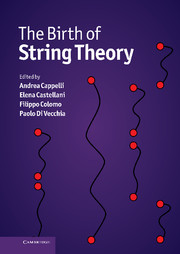Book contents
- Frontmatter
- Contents
- List of contributors
- Photographs of contributors
- Preface
- Abbreviations and acronyms
- Part I Overview
- EARLY STRING THEORY
- Part II The prehistory: the analytic S-matrix
- Part III The Dual Resonance Model
- Part IV The string
- TOWARDS MODERN STRING THEORY
- Part V Beyond the bosonic string
- 27 Introduction to Part V
- 28 From dual fermion to superstring
- 29 Dual model with fermions: memoirs of an early string theorist
- 30 Personal recollections
- 31 Aspects of fermionic dual models
- 32 The dual quark models
- 33 Remembering the dawn of relativistic strings
- 34 Early string theory in Cambridge: personal recollections
- Part VI The superstring
- Part VII Preparing the string renaissance
- Appendix A Theoretical tools of the Sixties
- Appendix B The Veneziano amplitude
- Appendix C From the string action to the Dual Resonance Model
- Appendix D World-sheet and target-space supersymmetry
- Appendix E The field theory limit
- Index
33 - Remembering the dawn of relativistic strings
from Part V - Beyond the bosonic string
Published online by Cambridge University Press: 05 May 2012
- Frontmatter
- Contents
- List of contributors
- Photographs of contributors
- Preface
- Abbreviations and acronyms
- Part I Overview
- EARLY STRING THEORY
- Part II The prehistory: the analytic S-matrix
- Part III The Dual Resonance Model
- Part IV The string
- TOWARDS MODERN STRING THEORY
- Part V Beyond the bosonic string
- 27 Introduction to Part V
- 28 From dual fermion to superstring
- 29 Dual model with fermions: memoirs of an early string theorist
- 30 Personal recollections
- 31 Aspects of fermionic dual models
- 32 The dual quark models
- 33 Remembering the dawn of relativistic strings
- 34 Early string theory in Cambridge: personal recollections
- Part VI The superstring
- Part VII Preparing the string renaissance
- Appendix A Theoretical tools of the Sixties
- Appendix B The Veneziano amplitude
- Appendix C From the string action to the Dual Resonance Model
- Appendix D World-sheet and target-space supersymmetry
- Appendix E The field theory limit
- Index
Summary
In this short account Iwould like to think about the remarkable history of the development of relativistic string theories which have gradually renewed the very foundations of theoretical high energy physics. For lack of time and precise knowledge, Iwill stick tomy own personal contribution at the beginning of this wonderful story, and refer to other contributions in this Volume to complete the picture.
The year 1968–1969, marked a turning point in my career, not only because string theory came into the fore. I was just returning from two years as a postdoc at New York University, where I had met J. Wess (a visitor for one year), B. Zumino (then the head of the Theory Group located at the Courant Institute), K. Symanzik, W. Zimmermann and D. Zwanziger. My earlier interests were mostly on dispersion relations, Regge poles, and S-matrix theory, but at NYU, I had been fully converted to local field theory, and much impressed by the power of symmetries in that context, be they local or global, exact or (spontaneously) broken. Of course, this year saw the beginning of string theory, which was however initially developed using the covariant operator method within the context of S-matrix theory, giving what looked like a realization of G. Chew's programme. I refer to the contribution of Ademollo to this Volume for a review of the precursory works which led Veneziano to write his celebrated four-point function.
- Type
- Chapter
- Information
- The Birth of String Theory , pp. 407 - 413Publisher: Cambridge University PressPrint publication year: 2012
- 1
- Cited by



